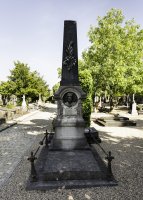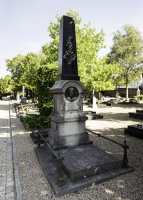Description
Nicolas Steffen-Pierret was born in Mühlenbach on 29 November 1830 and is best remembered for being a social writer. His birth name was Nicolas Steffen, but he later took the surname of his wife, Elisabeth Pierret, to differentiate himself from his brother and nephew, both also named Nicolas. He generally signed his work N. S. Pierret, using his wife's surname, but sometimes he hyphenated his name to Steffen-Pierret. After finishing primary school, he went to work in his father's gardening business. He then went on to train as a carpenter, and after completing his apprenticeship went to Reims and Paris to hone his craft. From 1862 to 1898, he worked as foreman in the carpentry workshops of the Eastern Railway Company (Compagnie des Chemins de Fer de l'Est), and then the General Directorate of Railways in Alsace-Lorraine (Direction Générale des Chemins de Fer d'Alsace-Lorraine), both of which operated the "Guillaume Luxembourg" railway network in the Grand Duchy.

N. S. Pierret earned renown for the poems, plays and stories he wrote in Luxembourgish and German. Most of his poems are about the everyday lives of craftspeople. They glorify labour, the simple joys of life and courage in the face of adversity. With this work, he connected to a specific readership. He also gave his work a patriotic flair, drawing inspiration from themes and figures from the country's history. The poems “Mansfèld fir émmer!” (1877) and “D'Letzeburger Marseillaise” (1893) best illustrate this genre. His plays also centre around the everyman.
Today, N. S. Pierret is celebrated for his popular prose, which earned him a place in the Luxembourgish literary canon. Between 1898 and 1900, he published a collection of his own short stories – entitled “Geschichten aus der Ucht” – in the Luxemburger Land-Kalender, of which he was joint editor.
N. S. Pierret also published stories in the Der Arbeiter newspaper, which was in circulation from April 1878 to January 1882.
This weekly publication, aimed at Luxembourgish labourers, was a precursor to the Escher Tageblatt. Some of N. S. Pierret's texts and plays were set to music by Gustav Kahnt, Laurent Menager and Guillaume Stomps.








N. S. Pierret passed away on 27 October 1899 in Limpertsberg. Although the Luxemburger Wort only made a brief mention of his death in its "Civil registry" section, L'indépendance luxembourgeoise published a glowing obituary. N. S. Pierret's work was considered first and foremost political, and literary critics offered nuanced analyses of his diverse literary opus. Luc Housse, a lawyer and socialist municipal councillor, spearheaded an initiative to erect a monument to him in a prominent spot in the cemetery. Housse also chaired the Comité de l'œuvre N.S. Pierret. The initiative was well received, but its impact did not extend beyond the local community and only the Fanfare du Grund, the Cercle amical du Limpertsberg and some friends attended the funeral. The money to install the monument was collected through a national fundraising campaign. The City granted a free concession in perpetuity for the cemetery plot where the monument was to be erected, as it later did for monuments to the composers Jean-Antoine Zinnen and Laurent Menager. In 1902, with the consent of his wife and son, N. S. Steffen was exhumed and then reburied alone under the monument that was erected to him by the committee responsible for the initiative. However, no government officials attended the unveiling ceremony. The monument is an obelisk adorned with a palm leaf and laurel wreath. It was designed by the architect Georges Clement, a Limpertsberg native. At the base of the monument are the following words: "Fum Weltemiir duerch Sturm a Wand gedriwen/ huet oft mei Liewensschlässchen fill gelidden/ een eenzegen Rettungshafen wor mir bliwwen / hei fond ech endlech Ro a Friden". The bust and stonework were crafted by Théophile Mergen, a prominent sculptor who was also based in Limpertsberg.
Below are some of the works that make up the literary legacy left by Nicolas Steffen-Pierret: “De Mêschter Neimân. Komedestéck mat Gesank an èngem Akt, Musek fum G. Kahnt”. „De Wierwollef, Komedestéck mat Gesank an éngem Akt, Musék fum L. Menager”; „Eng parti Lamock, e Bild no der Natur gezéchent“; „Den Invalid, Komedestéck mat Gesank an èngem Akt, Muséck fum G. Kahnt”; „Op Peîschtméndég, e Komedtéck mat Gesank an èngem Art fum G. Kahnt”; „Engel an Deiwelcher oder de Steidt fir dem Félten seng Leich, e Komedestéck an zwén Akten“. „Onserer Lider a Gedichter an onserer Letzeburger-deitscher Sproch“; „Aus den Erernneronge fun engem Letzeburger“; “Liéwensmid”; “Eng onhelmlech Nuecht”.





















